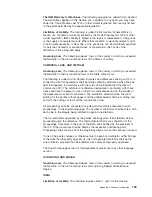
A
Root
B
C
Blocked
Port 1
Port 1
Port 1
Port 1
Port 1
Port 1
Port 2
Port 2
Port 2
Port 2
Port 2
Port 2
Designated
BPDUs Lost
BPDUs Lost
In this example, port 2 on bridge B can receive but not transmit packets. Port 2 on
bridge C should be in the blocking state, but since it can no longer receive BPDUs
from port 2 on bridge B, it will change to the forwarding state. If the failure exists at
boot, STP will not converge and restarting the bridges will have no effect.
Note:
In the previous example, restarting the bridges will provide a temporary
resolution.
This type of failure is difficult to detect because the Link-state LEDs for Ethernet
links rely on the transmit side of the cable to detect a link. If a unidirectional failure
on a link is suspected, it is usually required to go to the console or other
management software and look at the packets received and transmitted for the port.
For example, a unidirectional port will have many packets transmitted but none
received, or vice versa.
Packet corruption
Packet corruption can lead to the same type of failure. If a link is experiencing a
high rate of physical errors, a large number of consecutive BPDUs can be dropped
and a port in the blocking state would change to the forwarding state. The blocking
port would have to have the BPDUs dropped for 50 seconds (at the default
settings) and a single BPDU would reset the timer. If the Max. Age is set too low,
this time is reduced.
Resource errors
The switch performs its switching and routing functions primarily in hardware, using
specialized application specific integrated circuits (ASICs). STP is implemented in
software and is thus reliant upon the speed of the CPU and other factors to
converge. If the CPU is over-utilized, it is possible that BPDUs might not be sent in
a timely fashion. STP is generally not very CPU intensive and is given priority over
other processes, so this type of error is rare.
It can be seen that very low values for the Max. Age and the Forward Delay can
result in an unstable spanning tree. The loss of BPDUs can lead to data loops. The
diameter of the network can also cause problems. The default values for STP give
a maximum network diameter of about seven. This means that two switches in the
Appendix D. Understanding and troubleshooting the Spanning Tree Protocol
135
Summary of Contents for BladeCenter Management Module
Page 1: ...IBM BladeCenter 4 Port Gb Ethernet Switch Module Installation and User s Guide ERserver ...
Page 2: ......
Page 3: ...IBM BladeCenter 4 Port Gb Ethernet Switch Module Installation and User s Guide ERserver ...
Page 9: ...Japanese Voluntary Control Council for Interference VCCI statement 159 Index 161 Contents vii ...
Page 10: ...viii IBM BladeCenter 4 Port Gb Ethernet Switch Module Installation and User s Guide ...
Page 18: ...xvi IBM BladeCenter 4 Port Gb Ethernet Switch Module Installation and User s Guide ...
Page 32: ...14 IBM BladeCenter 4 Port Gb Ethernet Switch Module Installation and User s Guide ...
Page 92: ...74 IBM BladeCenter 4 Port Gb Ethernet Switch Module Installation and User s Guide ...
Page 134: ...116 IBM BladeCenter 4 Port Gb Ethernet Switch Module Installation and User s Guide ...
Page 136: ...118 IBM BladeCenter 4 Port Gb Ethernet Switch Module Installation and User s Guide ...
Page 138: ...120 IBM BladeCenter 4 Port Gb Ethernet Switch Module Installation and User s Guide ...
Page 155: ...Appendix D Understanding and troubleshooting the Spanning Tree Protocol 137 ...
Page 158: ...140 IBM BladeCenter 4 Port Gb Ethernet Switch Module Installation and User s Guide ...
Page 172: ...154 IBM BladeCenter 4 Port Gb Ethernet Switch Module Installation and User s Guide ...
Page 177: ...Japanese Voluntary Control Council for Interference VCCI statement Appendix G Notices 159 ...
Page 178: ...160 IBM BladeCenter 4 Port Gb Ethernet Switch Module Installation and User s Guide ...
Page 183: ......
Page 184: ... Part Number 59P6530 Printed in U S A 1P P N 59P6530 ...
















































